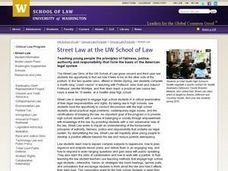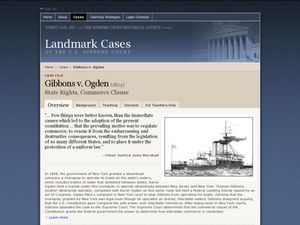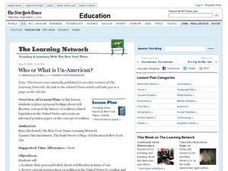Curated OER
The "Big Four"
Students identify the four individuals who are identified as the "Big Four", examine the years they were on the bench together, and look and the impact they made in key cases.
Curated OER
The Impact of Hazelwood on School Publications
Ninth graders explore the Supreme Court Case Hazelwood School District v. Kuhlmeier. In this American Government lesson, 9th graders research the recent history of censorship and how the courts have been involved in either protecting or...
Curated OER
Just how broken is the Senate?
Twelfth graders examine the role of the Senate in the United States. In this American Government lesson plan, 12th graders read various articles and answer questions to these articles. Students write a letter to their Senator on a...
Curated OER
Mueller v. Allen
Students investigate a First Amendment legal case involving religion, education, and reimbursement of tuition payments. They research the background of the cases and its precedents.
Curated OER
Civil Liberties and War Powers: Korematsu v. United States
Eleventh graders compare and contrast Supreme Court decisions dealing with the application of civil rights during times of war, with emphasis on discrimination and detention. Working in groups, 11th graders review cases and analyze how...
Curated OER
The Supremes
Students discuss steps cases go through to reach Supreme Court, examine Bill of Rights, and rank rights in order of importance to them. Students then research Supreme Court case dealing with one of first ten amendments, and write about...
Curated OER
U.S. Constitution and Amendments
Students explore the framework of government and examine the Constitution to see its impact on their lives.
Curated OER
American Revolution and Constitution Take Home Assessment
In this early American history worksheet, students create posters that feature the branches of government as established by the U.S. Constitution. Students also research founding ideals of the nation and use Venn diagrams to compare and...
Curated OER
Introduction to the Constitution: The First Three Articles of the Constitution, Separation of Powers
High schoolers review the first three articles of the United States Constitution. In groups, they examine the three branches of government and their function. They follow the path of a bill until it becomes law and discuss Congress' role.
Administrative Office of the US Courts
Nomination Process
"I do solemnly swear that I will support and defend the Constitution of the United States..." Scholars investigate the nomination process of Supreme Court justices when assuming office. Through examination of primary and secondary...
Curated OER
The Rule of Law
Young scholars examine the rule of law and government in this civics instructional activity. They discover the origins and how it impacts them on a daily basis. They also analyze its role in the judicial system.
Curated OER
Discovering Democracy in Canada: Federal Perspectives
Tenth graders research one aspect of government. They teach their peers co-operatively about the key elements of Democracy in Canada at the Federal Level by giving group presentations.
Curated OER
Utah's Legislative Branch: How a Bill Becomes a Law
Seventh graders explain the steps by which a bill becomes a law. They research how a bill becomes a law within the three branches of Utah's government and synthesize their research and discussion in a classroom representation of government.
Curated OER
Michigan Constitution and the Legislative Branch
Students explore online resources to compare and contrast the different constitutions the state of Michigan has had. They continue their exploration of various websites, focusing on the legistlative branch and the homepage of their local...
Curated OER
Gibbons v. Ogden (1824)
Students examine state rights and the commerce clause. For this Supreme Court lesson, students examine primary documents from Gibbons v. Ogden and discuss the implications of the decision.
Curated OER
Supreme Court Shake-Up
Learners examine the role of the Supreme Court through an interactive program. They analyze the history of the Court and its members. They finally explore how the Supreme Court works.
Curated OER
Michigan Court System (Part 1) (Middle School)
Students identify the courts that make up the Michigan judicial system. They explore the responsibility of each court and diagram how cases move to the Supreme Court. They compare and contrast the different types of courts.
Curated OER
Full Court Press
Students investigate the Supreme Court's role and function in the federal government and examine how Chief Justice Rehnquist's illness might affect the future of the Court. They write letters to President Bush on the Supreme Court...
Curated OER
Introduction to the History of the Michigan Supreme Court
Pupils identify the players, events and changes in the history of the Supreme Court of Michigan. They explain the purpose of the Court in state government. They summarize the role and purpose of the Court.
Curated OER
iCivics: Executive Command
Students explore the role of President of the United States. In this executive branch lesson plan, students play an online game that requires them to consider the needs of Americans as they act as president.
Curated OER
Moot Court
Learners research and discuss court cases in preparation for Moot Court. Student attorneys research precedents involving their cases, while student justices research political ideology of Supreme Court Justices. Student attorneys then...
Curated OER
Who or What is Un-American?
Students explore concepts about civil liberties, research the history of sedition-related legislation in the U.S. and create a position paper on the topic.
Curated OER
Supreme Court Newspaper
Young scholars examine the purpose and responsibilities of the Supreme Court and its justices. In groups, they research a specific case and identify how the Supreme Court affects their lives. Using the information they find, they...
Curated OER
Ethnicity, Gender and the Courts
Eleventh graders explore their own beliefs about the qualities that make someone qualified to sit on the Supreme Court. In this American Government activity, 11th graders write about and debate the ethnic, religious, and gender makeup...

























